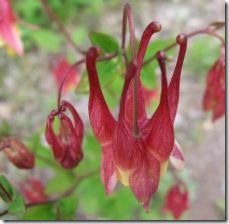Columbines are native to North America and Europe, and their unique flowers are said to resemble a gathering of doves or the open talons of an eagle. Columbines reach 24 to 36 inches in height and bloom in the springtime. They are an attractive addition to both perennial beds or wildflower gardens.
Colors and Varieties
-
Most North American columbine plants are a deep pinkish red with a yellow center (there is also a rarer pure yellow variety). European columbines have slightly smaller flowers than North American columbines, and they come in shades of purple, white, blue and salmon. The flowers of wild columbines are smooth and open, like bells, while some cultivated varieties boast fluffy double blooms. When planting different species of columbines, bear in mind that they easily hybridize with each other, so if you are trying to plant a North American native wildflower garden, you should refrain from planting any European or cultivated columbines.
Soil, Sun and Water
-
In the wild, columbines are woodland plants that often grow in rocky or thin soil, sometimes even growing directly on a cliff face. In the garden, columbines thrive best in part-sun to part shade, and the soil should be loose, well drained and slightly acidic. Columbines tolerate dry conditions, and need watering only in times of drought. Columbines are very hardy and are good flowers to grow in areas of your garden where it might be too shady or too dry or the soil is too poor for other flowers.
Caring for Columbine
-
Columbine seeds require a period of cold stratification to germinate, and the easiest way to accomplish this is to sow seeds in the fall. Loosen the soil with a rake, spread the seed, and cover with a very thin layer of soil (approximately 1/8 of an inch). Columbines generally will not bloom during their first spring. For quicker blooms, you can purchase transplants and plant them in the early spring. Columbines are perennials, and individual plants live 3 to 5 years. However, the columbine easily reseeds itself, and under the right conditions a patch of columbines will thrive and expand for years to come. Columbines rarely suffer from any disease or pest infestation, and require little to no fertilizer.
Wildlife Benefits
-
Columbine–especially native columbine (Aquilegia canadensis)–is an important nectar source for hummingbirds, as well as butterflies, bees and other insects. A hummingbird or butterfly garden in North America might include other native wildflowers such as bee balm, milkweed, jewelweed or lupine.


Deprecated: strpos(): Passing null to parameter #1 ($haystack) of type string is deprecated in /home/agriviek8Qv/agriviet.net/public_html/wp-includes/comment-template.php on line 2522